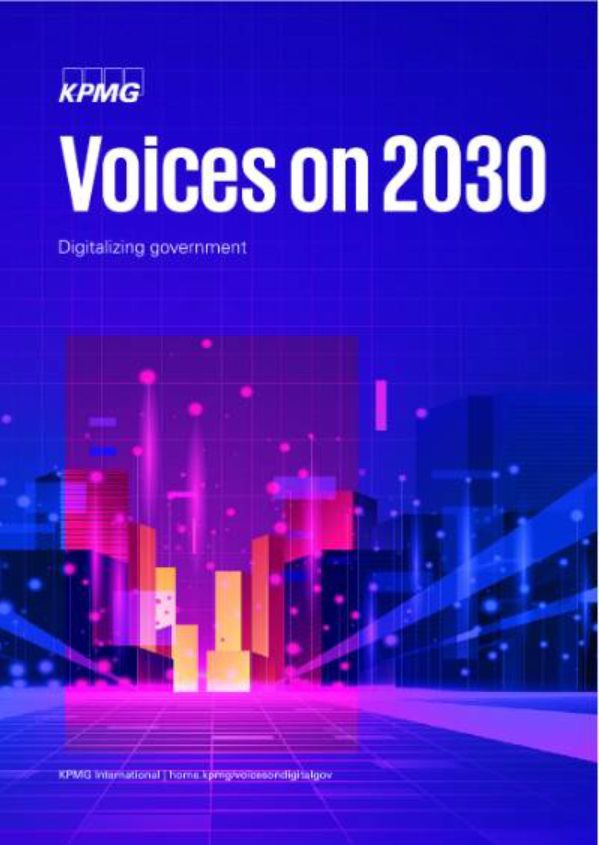The year is 2030. People and technology live in harmony. Trust is embedded into data. Interactions are cognitive. And government services are seamless, customer-centric and intuitive.
It is less than eight years away, but expectations for 2030 are already sky high. Across many spheres — technological, social, political, economic and others — transformation is underway and huge goals are being set. So what will the world look like in 2030? And what can public sector organisations do to help ensure they meet these expectations?
We spoke with leaders and disruptors from around the world, across the public and private sector, to uncover answers to these questions.
Explore our summary of predictions below and download our full report for a glimpse into the future of digital government and the potential opportunities it holds.
Explore 5 areas of disruption in 2030
Cognitive technologies enable natural and intuitive human interactions
Government in the next decade is largely predictive, and feels somewhat invisible, with tech-enabled services and analytics that wrap around the needs and expectations of the citizens.
Government services are seamless and intuitive
Sensors and Internet of Things (IoT) data are used to predict citizen needs; metaverse service channels provide interaction; and augmented humans and bots deliver on expectations.
Web 3.0 unlocks a world of new possibilities
Web 3.0 and the metaverse have created spaces where citizens can interact with government, healthcare professionals, private companies and communities. Increasingly, virtual worlds become the channel of choice for citizens and governments.
Governments rethink their role in a decentralised world
The rise of Web 3.0 and the metaverse power a shift in how governments regulate industries, through to the way they develop and deliver services.
Agile, cooperative and resilient operating models
Many governments now actively ‘crowdsource’ from citizen developers to create a resilient and agile network of capabilities that drives diversity and enhances trust.
Transformation takes on many shapes in the public sector
Governments are quickly developing their capabilities across domains to transform the core fundamentals of what they do, how they do it and where it gets done.
People take ownership of their own data
Consumers have moved quickly to adopt the decentralised and self-sovereign data aspects of Web 3.0. Citizens and businesses are eagerly taking their data back from centralised and opaque data lakes they resided in before.
Trust and data security are redefined
The ownership of every piece of data is documented, powering trust in a Web 3.0 environment. Increased accessibility to new technologies such as quantum computing also reshapes the way security is managed.
Governments are forced to adapt
Demands for a different way of organising data has led governments to focus on creating innovative solutions and platforms that respond to the needs, wants and expectations of citizens and customers.
Low-code/no-code solutions and automation tools are commonplace
With low-code/no-code platforms, almost every citizen has the tools and capabilities they need to create or customise an app. Drag-and-drop user interfaces and pre-built components are replacing line-by-line coding. Citizen developers are everywhere.
Citizen developers are transforming their lives and organisations
The adoption of low-code/no-code gives workers the power to customise solutions to meet their needs and realities, driving enhanced productivity and efficiency. It also empowers public and private organisations to become more agile and customer-centric.
Digital natives and new capabilities change the nature of work
Newer generations of public sector employees are already comfortable using a wide range of tools and solutions in their day-to-day jobs. In the future, they don't want to just use them — they want to help create them, be a part of their evolution and guide their future use.
ESG progress is accurately measured
Sensors and IoT devices provide detailed data on actions and activities. Individuals get an alert if they exceed carbon footprint limits, companies can track the source of their carbon emissions, governments can track emissions by entity, location and time.
Digital twins and virtual worlds hold up mirrors
Investments into space infrastructure helps measure and manage environmental change on earth. A combination of different data sources provides a clearer picture of human impacts and risks.
Government investments spark sustainable growth
Government investment helps spawn growth industries and service areas that serve the wider population, create new jobs, attract talent from overseas and drive further investment.
Start today. Be ready for tomorrow.
Based on these predictions, what tangible steps can government and public sector organisations start taking today? Here are six ideas.
Start fresh with a bold, holistic vision
The world of 2030 may not be an incremental change from today. It could offer a new paradigm that requires fresh thinking and bold, holistic action. Instead of starting with the status quo, start understanding the needs of citizens. And go from there.
Learn about Web 3.0 technologies and trends
Web 3.0 is very different from the internet of the past. It is founded on different technologies and controlled in different ways. It may change the way you think about your business or area of focus, and is worth learning about now.
Prepare your future talent and workforce models
Think about how you are going to encourage digital natives to join and stay with your organisation. And consider how you will empower current employees to thrive and innovate in a Web 3.0 customer-centric world.
Reassess your governance models
New governance practices are being introduced that may require significant changes in the way regulation is created and enforced. At the same time, the decentralisation of data will require new concepts around data protection and consumer security.
Picture yourself in the metaverse
There is little doubt that the metaverse is becoming a key channel and technology for connecting people with governments and service providers. Act now on pilot projects to explore what your presence in a metaverse might look like and how you could serve your customers there.
Form your ecosystem
In a decentralised world, the government is part of an ecosystem of players and enablers that work together to meet the needs of citizens. Now is the time to start forming those relationships and engaging in pilot projects to help build experience and define new models.
Get in touch
Connect with us
- Find office locations kpmg.findOfficeLocations
- kpmg.emailUs
- Social media @ KPMG kpmg.socialMedia



